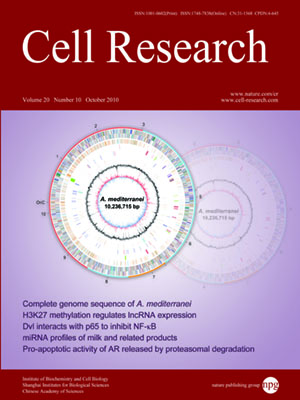
Volume 20, No 10, Oct 2010
ISSN: 1001-0602
EISSN: 1748-7838 2018
impact factor 17.848*
(Clarivate Analytics, 2019)
Volume 20 Issue 10, October 2010: 1128-1137
ORIGINAL ARTICLES
Identification and characterisation of microRNAs in raw milk during different periods of lactation, commercial fluid, and powdered milk products
Xi Chen1,*, Chao Gao1,*, Haijin Li1,*, Lei Huang1, Qi Sun1, Yanye Dong1, Chunliang Tian2, Shengpu Gao3, Hailin Dong2, Danping Guan2, Xiaoyun Hu2, Shujian Zhao2, Liang Li1, Lin Zhu1, Qiao Yan1, Junfeng Zhang1, Ke Zen1 and Chen-Yu Zhang1
1Jiangsu Diabetes Center, State Key Laboratory of Pharmaceutical Biotechnology, School of Life Sciences, Nanjing University, 22 Hankou Road, Nanjing, Jiangsu 210093, China
2Nanjing MicroMedMark Biotech Co., Ltd., 88 Zhujiang Road, Nanjing, Jiangsu 210008, China
3China National Institute of Standardization, ZhiChun Road, HaiDian District, Beijing 100088, China
Correspondence: Chen-Yu Zhang, Ke Zen, Junfeng Zhang,(cyzhang@nju.edu.cn; kzen@nju.edu.cn; jfzhang@nju.edu.cn)
Recent baby formula milk powder contamination incidents have shown that the classic markers or standards in milk quality control are insufficient in identifying 搈anipulated� poor-quality milk. In the present study, we demonstrated for the first time that cow milk contains large amounts of microRNAs (miRNAs) and that the unique expression profile of milk-specific miRNAs can serve as a novel indicator and possible new standard for the quality control of raw milk and milk-related commercial products, such as fluid milk and powdered formula milk. First, using Solexa sequencing, we systematically screened miRNA expression in raw milk and identified a total of 245 miRNAs in raw milk. Unlike other classic biomarkers whose expression levels are nearly identical at different periods of lactation, individual miRNAs can be significantly altered during lactation process, implicating that miRNAs may be a more accurate indicator to reflect the quality alteration of milk. Second, using TaqMan probe-based miRNA quantitative RT-PCR, we further identified seven miRNAs that have a relatively consistent expression throughout the lactation process, and more importantly, the expression profile of these seven milk-specific miRNAs can serve as an ideal biomarker for discriminating poor-quality or 搈anipulated� milk from pure raw milk, as well as for the quality control of commercial milk products, such as fluid milk and powdered formula milk. Together, our findings provide a basis for understanding the physiological role of milk miRNAs and a new potential standard for determining the quality of raw milk or milk-related commercial products.
Cell Research (2010) 20:1128-1137. doi:10.1038/cr.2010.80; published online 15 June 2010
FULL TEXT | PDF
Browse 2730


